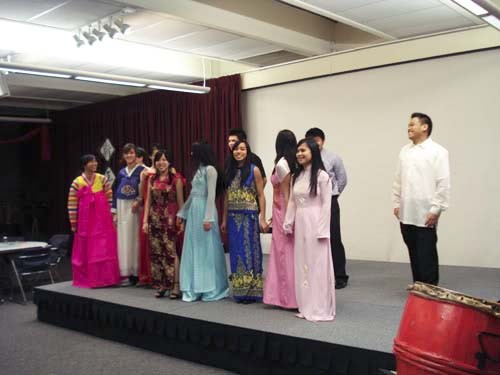Lion dances, Mulan to kick off Year of the Rabbit

Courtesy Photo / Stephanie Ly A performance at a past Asian New Year, hosted by the Asian Student Union
Jan 31, 2011
Asian cultures will bid farewell to the year of the Tiger on Wednesday and say hello Thursday to the year of the Rabbit.
To celebrate the occurrence, the Grand Valley State University Asian New Year celebration will take place from 6 p.m. to 9 p.m. Thursday in the Grand River Room of Kirkhof Center.
The Asian Student Union will provide traditional Asian cuisine such as egg rolls, crab rangoons, lo mein, fried rice, sushi, beef dishes, curry chicken, honey chicken, white rice, fortune cookies and other snacks.
The event will feature both traditional and modern performances from various Asian ethnic groups.
The Asian Student Union will perform a short skit about the original tale of Mulan and will walk in a cultural fashion show. Delta Phi Lambda, an Asian-interest sorority, will perform a fan-dance. Students will play piano and traditional instruments from East Asian nations. Bee Yang, president of the Hmong American Student Association, and Delta Phi Lambda member Linda Truong will sing.
The event will also bring outside performers. University of Michigan’s group Function will dance in a contemporary-modern style, and three performers from a Grand Rapids martial arts studio will give a traditional Lion Dance.
The Chinese developed their calendar, a system known as the lunar calendar in the West, thousands of years ago.
Chinese New Year falls on the second new moon after the winter solstice, and the new year celebration marks the opening of the Spring Festival.
“Chinese count the year with the Western calendar, and they use the Chinese calendar to mark celebrations,” said Patrick Shan, associate professor of history with a specialization in Chinese history.
Because China provided the foundations for other East Asian cultures – mainland China, Hong Kong, Indonesia, Macao, Philippines, Singapore, Taiwan, Vietnam, Korea, Tibet, Bhutan, Mongolia and Japan – the Chinese influenced their neighbors’ cultural celebrations.
Countries in East Asia adopted the Chinese cultural practices, such as the use of the zodiac to name each year with an animal.
“The Chinese developed a superstition to predict the future,” Shan said. “The animals symbolize different characteristics.”
This year is the year of the rabbit, whose major characteristic is luck.
“The Asian New Year is cultural, religious and functional,” said Mitchell Diep, president of the Asian Student Union.
New Year began with the myth of a monster that terrorized a Chinese city. Now, citizens ward away the monster with food offerings, fireworks, lanterns, new clothes and the color red.
These defensive techniques appear at various times throughout the course of the new year, also known as the Spring Festival.
The Spring Festival consists of 15 days of celebration.
The first day, the most important day, everyone gathers for a family meal.
Diep’s family gathers on the first day of the Spring Festival to share in the standard family celebration, and he enjoys the people and the food.
“I have a giant family, consisting of upwards of 70 people, and just all meet in one house,” he said. “And from there we have this cuisine that is just amazing. This food – usually duck, sometimes a whole pig or any kind of pork dish, fish … Just getting the family together and respecting our elders and respecting our heritage.”
At the new year, people look for three ideas: prosperity, well-being and luck.
“My favorite thing about celebrating Chinese New Year is just being able to get together with my family – just spending time with them and catching up and eating a nice dinner together,” said Stephanie Ly, vice president of the Asian Student Union.
Ly also encourages students to learn more about Asian culture and to attend the New Year celebration at GVSU.
“People are used to seeing their own cultures and traditions, and it gives them a chance to see different perspective,” she said.

























